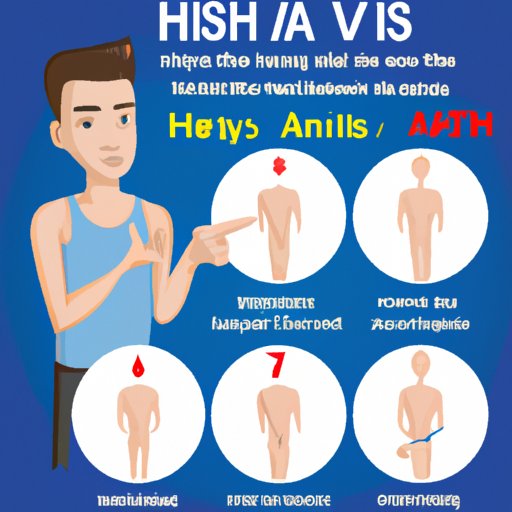
Introduction
HIV (human immunodeficiency virus) is a life-changing diagnosis that affects millions of people worldwide. While HIV can affect anyone, men are more vulnerable to contracting the virus through certain risky behaviors such as unprotected sex and sharing needles. It is essential to be aware of the symptoms, risk factors, testing options, transmission methods, stages, prevention, and treatment options for HIV in men to be able to take the necessary steps to prevent transmission or seek medical attention if needed. This article will take a closer look at each of these topics, emphasizing the importance of being informed and proactive when it comes to HIV in men.
Understanding the Symptoms
Men with HIV may experience different symptoms at different stages of the infection. Some of the most common symptoms include severe flu-like symptoms, swollen lymph nodes, fatigue, night sweats, and rashes. HIV can also cause neurological symptoms, such as confusion and memory loss. However, it is important to note that many people with HIV may not experience any symptoms initially, making it difficult to diagnose.
Common Risk Factors
There are several common risk factors that make men more vulnerable to HIV, including unprotected sex, sharing needles or other drug-injecting equipment, and having multiple sexual partners. It is important to be aware of these risk factors and take measures to reduce the risk of contracting HIV, such as using condoms during sexual activity and avoiding drug use.
Testing
Getting tested for HIV is essential, as early detection and treatment can greatly improve the outcome for people living with the virus. There are several ways to obtain an HIV test, including scheduling an appointment with a healthcare provider or using a home test kit. HIV testing involves taking a blood or oral fluid sample that is then sent to a laboratory for testing. After the test, a healthcare provider will discuss the results and the next steps.
Transmission
HIV can be transmitted in several ways, including during sexual activity, sharing needles or other drug-injecting equipment, and mother-to-child transmission during pregnancy, childbirth, or breastfeeding. It is important to be aware of these modes of transmission and take measures to reduce the risk of transmission, such as practicing safe sex and avoiding sharing needles.
Understanding the Stages
There are several stages of HIV, each with its unique symptoms and effects on the body. These stages include the acute infection stage, clinical latency stage, and AIDS. During the acute infection stage, individuals may experience severe flu-like symptoms soon after contracting HIV. During the clinical latency stage, also known as the asymptomatic stage, people may not experience any symptoms for up to a decade or longer. During the AIDS stage, the immune system is severely compromised, making individuals vulnerable to opportunistic infections and illnesses.
Prevention
There are several ways to prevent the transmission of HIV, including using condoms during sexual activity, avoiding sharing needles or other drug-injecting equipment, and taking pre-exposure prophylaxis (PrEP). PrEP involves taking a daily medication that can reduce the risk of contracting HIV. It is also important to practice safe sex and limit the number of sexual partners to reduce the risk of transmitting or contracting HIV.
Treatment
Timely diagnosis and treatment for HIV are essential for maintaining overall health and reducing the risk of complications. Antiretroviral therapy (ART) involves taking a combination of medications that work to suppress the virus and improve the function of the immune system. Other treatment options for HIV may include prophylaxis for opportunistic infections and other medications to manage symptoms and complications.
Conclusion
Awareness, testing, prevention, and treatment are essential when it comes to HIV in men. By being informed about the symptoms, risk factors, testing options, transmission methods, stages, prevention, and treatment options for HIV in men, individuals can take the necessary steps to prevent transmission, seek medical attention if needed, and maintain overall health and wellness.




